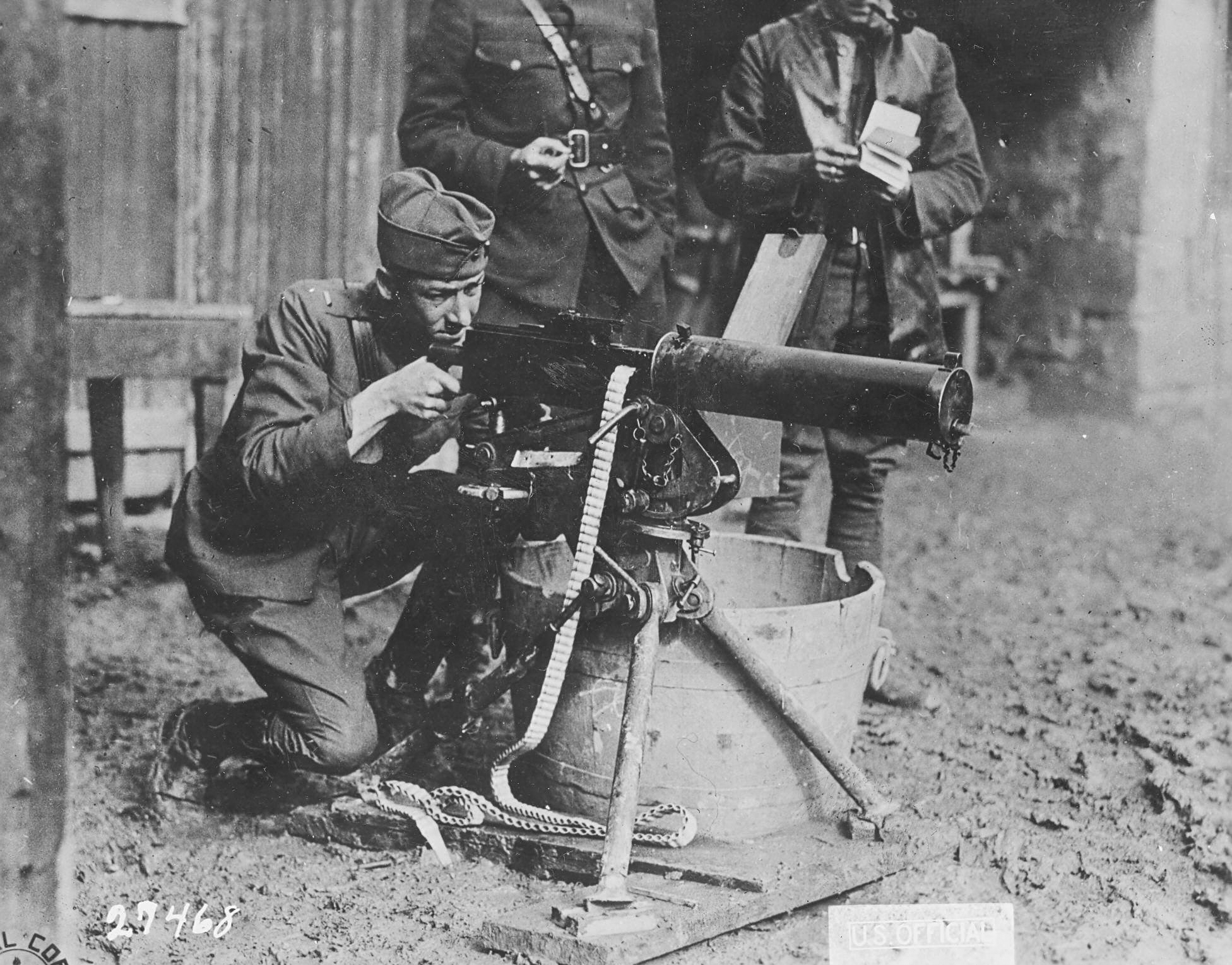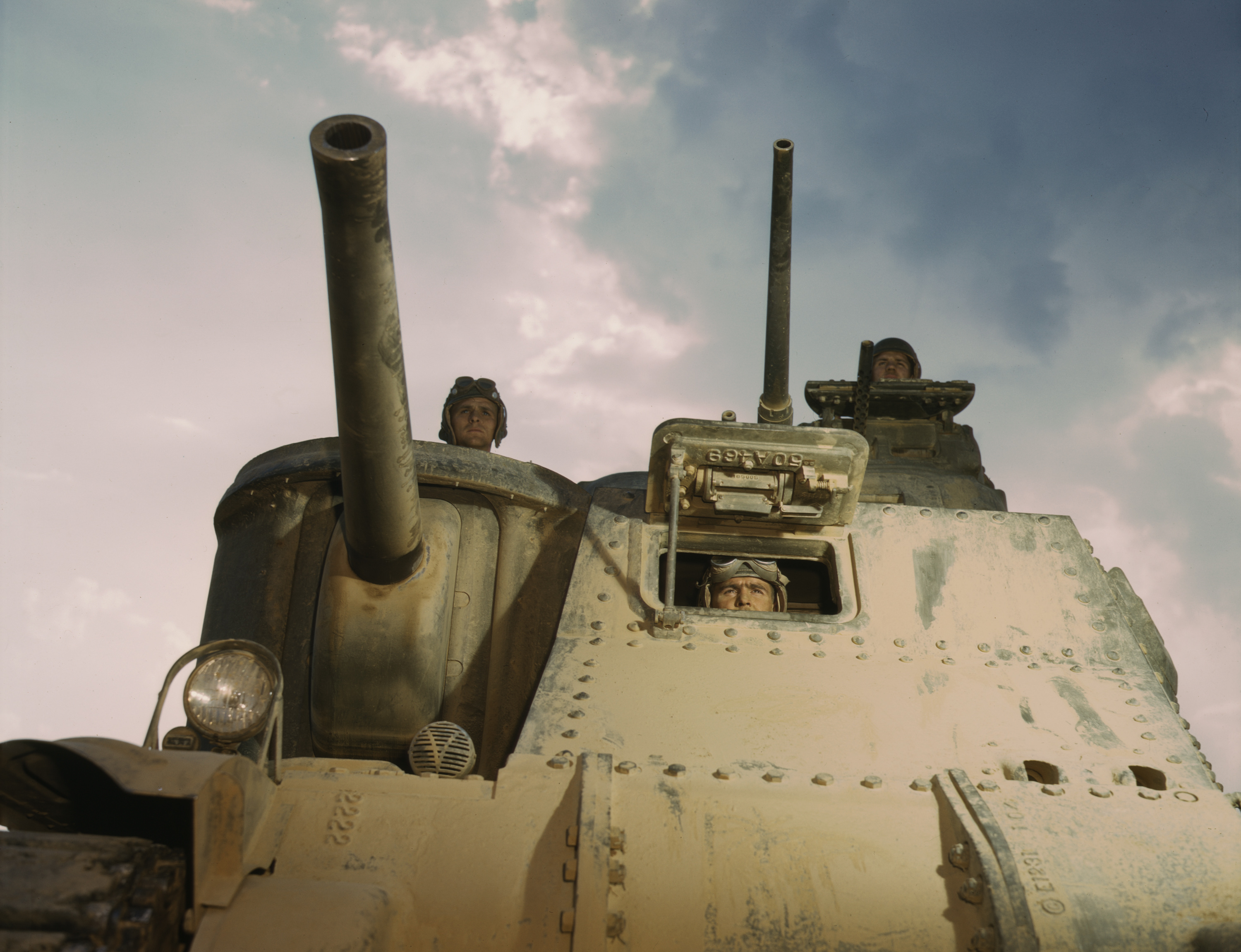|
Holt Gas–electric Tank
The Holt gas–electric tank was the first prototype tank built in the United States in a collaboration between the Holt Manufacturing Company (now Caterpillar Inc.) and the General Electric Company. The tank, built during 1917–1918, was the only one of its kind built, as testing proved it lacked the agility and maneuverability required. The crew number is often given as six, on the assumption there would be two machine gunners, a gunner and loader for the main gun, a driver and a commander. Construction The tank was based on a lengthened and modified version of the suspension of the Holt Model 75, with pivoting track frames. There were ten road wheels at each side. The tank was tall, long, and wide. The vehicle had a Holt , 4-cylinder engine fitted with a General Electric generator driving an electric motor for each track; a comparable petro-electric system had earlier been used for the French Saint-Chamond that also was fitted with a lengthened Holt suspension. To preven ... [...More Info...] [...Related Items...] OR: [Wikipedia] [Google] [Baidu] |
QF 2
QF may stand for: Businesses and organisations * Qantas, an Australian airline (IATA:QF) * Qatar Foundation The Qatar Foundation for Education, Science and Community Development () is a state-led non-profit organization in Qatar, founded in 1995 by then-List of emirs of Qatar, emir Hamad bin Khalifa Al Thani and his second wife Moza bint Nasser Al-Miss ..., a non-profit * Quiverfull, a Christian movement Military * Quds Force, an Iranian expeditionary unit * Quick-firing gun, an artillery piece * A gun breech that uses metallic cartridges; see British ordnance terms#QF * Q-Fire, a decoy fire site used in World War II Other uses * Quality factor, in physics and engineering, a measure of the "quality" of a resonant system {{disambig fr:QF ... [...More Info...] [...Related Items...] OR: [Wikipedia] [Google] [Baidu] |
M1917 Browning Machine Gun
The M1917 Browning machine gun is a heavy machine gun used by the United States armed forces in World War I, World War II, the Korean War, and the Vietnam War; it has also been used by other nations. It was a crew-served, belt-fed, water-cooled machine gun that served alongside the much lighter air-cooled Browning M1919. It was used at the battalion level, and often mounted on vehicles (such as a jeep). There were two main iterations: the M1917, which was used in World War I and the M1917A1, which was used thereafter. The M1917, which was used on some aircraft as well as in a ground role, had a cyclic rate of 450 rounds per minute. The M1917A1 had a cyclic rate of 450 to 600 rounds per minute. Design and development In 1900, John Moses Browning filed a patent for a recoil-powered automatic gun. Browning did not work on the gun again until 1910, when he built a water-cooled prototype of the 1900 design. Although the gun worked well, Browning improved the design slightly. Bro ... [...More Info...] [...Related Items...] OR: [Wikipedia] [Google] [Baidu] |
Gasoline Engine
A petrol engine (gasoline engine in American and Canadian English) is an internal combustion engine designed to run on petrol (gasoline). Petrol engines can often be adapted to also run on fuels such as Autogas, liquefied petroleum gas and Common ethanol fuel mixtures, ethanol blends (such as ''E10 petrol, E10'' and ''Common ethanol fuel mixtures#E85, E85''). They may be designed to run on petrol with a higher octane rating, as sold at petrol stations. Most petrol engines use Spark-ignition engine, spark ignition, unlike diesel engines which run on diesel fuel and typically use compression ignition. Another key difference to diesel engines is that petrol engines typically have a lower compression ratio. History The first practical petrol engine was built in 1876 in Germany by Nicolaus Otto, Nicolaus August Otto and Eugen Langen, although there had been earlier attempts by Étienne Lenoir in 1860, Siegfried Marcus in 1864 and George Brayton in 1873. Design Thermodynamic cycle ... [...More Info...] [...Related Items...] OR: [Wikipedia] [Google] [Baidu] |
Tank
A tank is an armoured fighting vehicle intended as a primary offensive weapon in front-line ground combat. Tank designs are a balance of heavy firepower, strong armour, and battlefield mobility provided by tracks and a powerful engine; their main armament is often mounted within a turret. They are a mainstay of modern 20th and 21st century ground forces and a key part of combined arms combat. Modern tanks are versatile mobile land weapons platforms whose main armament is a large- calibre tank gun mounted in a rotating gun turret, supplemented by machine guns or other ranged weapons such as anti-tank guided missiles or rocket launchers. They have heavy vehicle armour which provides protection for the crew, the vehicle's munition storage, fuel tank and propulsion systems. The use of tracks rather than wheels provides improved operational mobility which allows the tank to overcome rugged terrain and adverse conditions such as mud and ice/snow better than wheele ... [...More Info...] [...Related Items...] OR: [Wikipedia] [Google] [Baidu] |
United States
The United States of America (USA), also known as the United States (U.S.) or America, is a country primarily located in North America. It is a federal republic of 50 U.S. state, states and a federal capital district, Washington, D.C. The 48 contiguous states border Canada to the north and Mexico to the south, with the semi-exclave of Alaska in the northwest and the archipelago of Hawaii in the Pacific Ocean. The United States asserts sovereignty over five Territories of the United States, major island territories and United States Minor Outlying Islands, various uninhabited islands in Oceania and the Caribbean. It is a megadiverse country, with the world's List of countries and dependencies by area, third-largest land area and List of countries and dependencies by population, third-largest population, exceeding 340 million. Its three Metropolitan statistical areas by population, largest metropolitan areas are New York metropolitan area, New York, Greater Los Angeles, Los Angel ... [...More Info...] [...Related Items...] OR: [Wikipedia] [Google] [Baidu] |
Holt Manufacturing Company
The Holt Manufacturing Company began with the 1883 founding of Stockton Wheel Service in Stockton, California, United States. Benjamin Holt, later credited with patenting the first workable crawler ("caterpillar") tractor design, incorporated the Holt Manufacturing Company in 1892. Holt Manufacturing Company was the first company to successfully manufacture a continuous track tractor ( Hornsby in England manufactured at least two full length "track steer" machines, and their patent was later purchased by Holt in 1913, allowing Holt to claim to be the "inventor" of the crawler tractor.) By the early 20th century, Holt Manufacturing Company was the leading manufacturer of combine harvesters in the US, and the leading California-based manufacturer of steam traction engines. Holt Manufacturing Company operated from Stockton, California, until opening a satellite facility in Walla Walla, Washington, to serve the Pacific Northwest. In 1909 Holt Manufacturing Company expanded by p ... [...More Info...] [...Related Items...] OR: [Wikipedia] [Google] [Baidu] |
Caterpillar Inc
Caterpillar Inc., also known as Cat, is an American construction, mining and other engineering equipment manufacturer. The company is the world's largest manufacturer of construction equipment. In 2018, Caterpillar was ranked number 73 on the ''Fortune'' 500 list and number 265 on the Global ''Fortune'' 500 list. Caterpillar stock is a component of the Dow Jones Industrial Average. Caterpillar Inc. traces its origins to the 1925 merger of the Holt Manufacturing Company and the C. L. Best Tractor Company, creating a new entity, California-based Caterpillar Tractor Company. In 1986, the company reorganized itself as a Delaware corporation under the current name, Caterpillar Inc. It announced in January 2017 that over the course of that year, it would relocate its headquarters from Peoria, Illinois, to Deerfield, Illinois, scrapping plans from 2015 of building an $800 million new headquarters complex in downtown Peoria. Its headquarters are located in Irving, Texas, since 2022 ... [...More Info...] [...Related Items...] OR: [Wikipedia] [Google] [Baidu] |
General Electric Company
The General Electric Company (GEC) was a major British industrial conglomerate involved in consumer and Arms industry, defence electronics, communications, and engineering. It was originally founded in 1886 as G. Binswanger and Company as an electrical goods wholesaler based in London. It quickly adopted a then-unorthodox business model of supplying electrical components over the counter. In 1889, the business was incorporated as the General Electric Company Ltd, and became a public limited company 11 years later. During the 1890s and 1900s, the company heavily invested into electric lighting, a sector that proved to be immensely profitable in the long term. The GEC was heavily impacted by the outbreak of the First World War, supplying various goods to the military, and thus becoming a major player in the electrical industry. In 1921, a new purpose-built company headquarters (Magnet House) was opened in Kingsway, London; two years later, GEC's industrial research laboratories at ... [...More Info...] [...Related Items...] OR: [Wikipedia] [Google] [Baidu] |
Holt Tractor
The Holt tractors were a range of continuous track haulers built by the Holt Manufacturing Company of Stockton, California which were named after company founder Benjamin Holt. Between 1908 and 1913, twenty-seven of the first 100 Holt caterpillar track-type tractors were used on the Los Angeles Aqueduct project, which provided a good proving ground for these machines. Military use They were widely used by the British, French and American armies in the First World War for hauling heavy artillery including the BL 9.2-inch howitzer and the BL 8-inch howitzer. Around 2,000 Holt 75s along with 698 Holt 120s and 63 Holt 60s saw military use during the war. The French Schneider CA1 and Saint-Chamond and German A7V tanks were based on Holt tractors. Specification There were at least three models used for military purposes: the Holt 75, the Holt 120 and to a lesser extent the Holt 60. The Holt 75 was first produced in 1913. It used two tracks for steering. It had a maximum ... [...More Info...] [...Related Items...] OR: [Wikipedia] [Google] [Baidu] |
St Chamond (tank)
The Saint-Chamond () was the second French tank to enter service during the First World War, with 400 manufactured from April 1917 to July 1918. Although not a tank by a strict definition of a heavily armoured turreted vehicle, it is generally accepted and described as such in accounts of early tank development. It takes its name from the commune of Saint-Chamond where its manufacturers Compagnie des forges et aciéries de la marine et d'Homécourt (FAMH) were based. Born of the commercial rivalry existing with the makers of the Schneider CA1 tank, the Saint-Chamond was an underpowered and fundamentally inadequate design. Its principal weakness was its Holt caterpillar tracks. They were much too short in relation to the vehicle's length and weight (23 tons). Later models attempted to rectify some of the tank's original flaws by installing wider and stronger track shoes, thicker frontal armour and the more effective 75mm Mle 1897 field gun. Altogether 400 Saint-Chamond tanks ... [...More Info...] [...Related Items...] OR: [Wikipedia] [Google] [Baidu] |
Sponsons
Sponsons are projections extending from the sides of land vehicles, aircraft or watercraft to provide protection, stability, storage locations, mounting points for weapons or other devices, or equipment housing. Watercraft On watercraft, a sponson is a projection that extends outward (usually from the hull, but sometimes other parts of the vessel) to improve stability while floating, or to act as a securing point for other equipment. Vessels with unstable body shapes or unevenly distributed weight are likely to feature sponsons to help prevent capsizing or other instabilities. On many vessels, these projections from the main body of the vessel can be attached and removed quickly and fairly easily. Canoes and kayaks sometimes feature sponson attachments as well, for stability in rough waters. These differ from outriggers, which extend a significant distance away from the body of the craft, and are employed on craft designed for open waters. A sponson's terminus is close to the cra ... [...More Info...] [...Related Items...] OR: [Wikipedia] [Google] [Baidu] |




